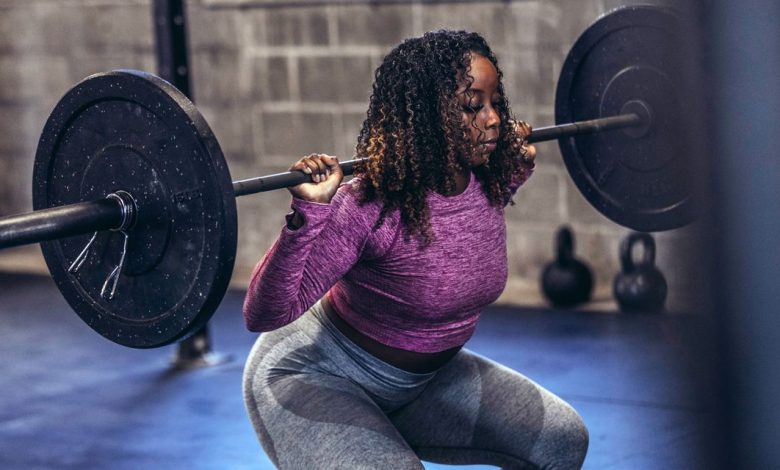Why the 5×5 Workout Might Be the Key to Serious Strength Gains

After months (maybe years) of performing three sets of 12 reps on repeat, your muscles are likely craving a fresh—and heavier—training routine. One path forward: the 5×5 workout plan.
The strength-building blueprint takes out the guesswork when you’re ready to start lifting more weight, and unlike some other popular plans, it’s a protocol fitness experts can actually get behind. Here’s what they have to say about the 5×5 workout—and how to tweak it to be most beneficial.
So what is the 5×5 workout, anyway?
The 5×5 workout is relatively simple. Basically, it involves:
- 5 reps of a certain exercise
- 5 sets of that exercise
- A rest of two to five minutes between each set
Usually, the moves are compound exercises, which call on multiple joints and muscle groups. And while you could use kettlebells and dumbbells to add load, most often you’re sticking with a heavy barbell for this training protocol. Think: barbell squat, bench press, and deadlift, Christina Myers, CSCS, a strength and conditioning coach in Birmingham, Alabama, tells SELF.
“A compound movement is going to have a little bit more of a lot of it more of a learning curve because it’s very technical…but it’s also going to yield more results,” Meghan Sak-Ocbina, DPT, CSCS, a physical therapist and strength coach in Puyallup, Washington, tells SELF. “You’re really training your nervous system to be more functional, and you can lift heavier loads with a compound movement.” That’s why you’d likely see a barbell row programmed in the 5×5 workout instead of a biceps curl, for instance.
You’ll use one load for all five sets, roughly 70% to 85% of your one-rep max that allows you to maintain good form, says Myers. This should feel like an eight or nine out of 10 RPE (rating of perceived exertion)—like you have just one or two reps left in the tank when you’re done with your set, adds Sak-Ocbina.
The goal: build strength and muscle with those heavier loads. “One of the things that kind of sets it apart is it is supposed to be done with a challenging weight, and it is supposed to have a focus on progressive overload,” says Myers. That means gradually upping the challenge placed on your muscles over time; in the case of the 5×5 workout, that involves increasing the weight used for a given exercise. For example, if, after a few weeks of training, you feel like you could bang out 10 reps during what should be a 5×5 barbell back squat, you might increase the load by 5% to 10%—once the weight goes up, your reps will fall down accordingly.
The benefits of the 5×5 workout method
1. It’s an effective entry point into heavier lifting for folks with a solid strength-training base.
If you do high rep counts and light weights for every single workout, the 5×5 workout plan could give your body the new stimulus it needs to see additional strength and muscle gains. “If you’re always doing three sets of 30 reps, like getting that ‘booty pump,’ that’s not going to be useful forever,” as your body will adapt to the stimulus, says Sak-Ocbina. “Whereas, if you were to switch it up and do a 5×5, for example, you probably will, first of all, get a lot stronger, and, second of all, gain some muscle.”
That’s because when you perform just five reps before resting, you’ll generally be able to lift heavier than you would if you were to do, say, 8 to 10 reps (hello, fatigue), Laura Su, CSCS, a strength and powerlifting coach in Seattle, tells SELF. This set-up allows you to test and build pure strength—how much force you’re able to generate against external resistance—especially if you’re new to testing yourself in this way, she adds. “I like to do five [reps] for beginner [powerlifters], just because they’re not ready for super, super high intensities yet; their body and their tissues haven’t adapted to loading up super-heavy,” says Su. “Five is a great rep range, just because it also allows them to have some skill practice on form and technique.”
Doing five sets of five heavy reps also gives you plenty of training volume (reps x sets x load), an essential element if it’s your one and only strength workout for the week, says Su. “It’s just a way to get enough total working sets per week that are actually going to be contributing positively toward strength and muscle gain,” she adds.
2. It’s relatively safe—and keeps ego lifting in check.
The protocol is pretty safe for barbell newbies, too. The low(ish) number of reps in each set gives you the chance to test heavier weights and practice your technique under that unfamiliar load, says Sak-Ocbina. But the rep count isn’t so low that you might be tempted to go super heavy for one single rep (and potentially compromise your safety) to reap the strength benefits, she explains. It’s one of the reasons why Sak-Ocbina says the 5×5 is a good entry point for heavier lifts.
3. It takes the guesswork out of your workout.
Plus, the basic structure of the 5×5 workout method is straightforward and simple to understand, says Myers. With your heavy lifts, you don’t have to change up your rep scheme for each exercise or dash around the gym looking for empty equipment to arrange a superset. Train your muscles with physical load while your brain gets a break from the mental one.
4. It supports progress.
Progressing your fitness with the 5×5 workout is as easy as popping more weight to the barbell, says Myers. There’s no need to mess around with other variables (like reps or sets), and no matter what gym you’re training in, you know the load you’re adding is always the same. “It’s very easy to measure strength increases on a basic lift like that,” she says. “When you get into things where you’re using a cable stack or a machine, and every machine is different.” So it’s like, “are you really getting stronger, or did you just use a different machine this week?”
But Sak-Ocbina says progress with the 5×5 can be even simpler than that. After all, you won’t be bumping up your weight every week—but you can still be progressing! Think about maximizing every single rep. Are you sinking as low as possible into your squat? Are you moving at a controlled tempo? Can you focus on engaging your lats—not just your glutes and hamstrings—during your deadlifts? “I think that just getting better at a movement is a really underrated way of progressively overloading,” she explains. “It’s most obvious to add a rep or add a set or add some load on the bar, but people often skip just getting better at something.”
The downsides of the 5×5 workout method
1. Dumbbells probably won’t cut it.
With such few reps to play with, you need to make each one count—and that means lifting heavy enough to challenge yourself. While dumbbells may work for folks first dipping their toes into fitness, you probably won’t be able to use them for long. Say you’ve done the 5×5 workout for a couple months and have built up to a squat with 60 pounds of load. Now imagine holding a dumbbell of that weight in front of your chest for goblet squats. It’s clunky, it’s hard to get it into the starting position, and it’s difficult to grip, says Su. You’ll typically want to use a barbell for easier set-up, especially as your load goes up and up.
What’s more, you’re able to make the tiniest increases in load with a barbell. Your gym might not stock dumbbells or kettlebells that go up in 2.5-pound increments, but there’s a good chance it has weight plates of that size available. In turn, it’s easier to stick to the five-rep standard while progressing safely.
2. It takes a significant amount of time.
Do you crave fast-paced workouts that last half an hour, max? The repetitive 5×5 workout might feel painfully slow, says Su. So some folks may be tempted to cut the (significant) rest between sets to move things along, but if you do so, you’d be messing with one of the core tenets of 5×5.
“You’re probably not going to be able to push the intensity as much as you could to elicit muscle growth or strength gains,” Su says.
3. It can leave some gaps in your fitness.
The 5×5 workout blueprint can help you make major strength strides with your barbell lifts. But it overlooks some of the other elements of fitness that make you a well-rounded athlete, like speed, agility, and power, says Myers. There’s no unilateral (a.k.a. single-sided) work or movement through all three planes of motion (think: moving forward and backward, side to side, and rotationally), and with its focus on compound exercises, smaller muscles may not get the attention they need, she explains. “If you only do those lifts, we’re kind of ignoring some stuff,” she says. This can be a problem, since giving these supporting muscles some love in your workouts can help support joint stability and protect from injury. Plus, training in all three dimensions can make real-life 3D activities, whether it’s gardening or hiking, feel more effortless.
How to start the 5×5 workout plan—and adjust it for your needs.
While you could do every exercise in your workout as a 5×5, it’s not always the most efficient (or mentally invigorating) approach. Instead, program one to three barbell exercises using the 5×5 blueprint, then round out your training day with accessory work.
Consider this sample lower-body training session: Start the workout with a couple sets of a few reps of a power-focused, nervous system-priming exercise (say, box jumps). Then, do a 5×5-style back squat—your main, strength-bolstering lift. Follow up with three sets of eight to 12 reps of accessory movements (e.g., single-leg deadlifts, split squats), suggests Sak-Ocbina. “You basically move from the most risky movements down to the least risky movements within a workout,” she says. “And the things that you’re most fatigued for, you’re not risking injury, but you’re also not necessarily gonna need as much energy or brain power.”
Instead of a lower-body day, you might structure it as a push day or a pull day, adds Myers. In the latter case, you might do a barbell deadlift and bent-over row as your main 5×5 workout lifts, with Nordic hamstring curls and reverse flies as your accessory moves.
The 5×5 is a high-volume program; between the low reps, high number of sets, and heavy weights, there’s a hefty amount of work performed. And that means it can also be a high-fatigue program, says Myers. In between sets, rest for at least two to five minutes so you’re able to continue pushing that heavy barbell. Outside of the gym, make sure you’re fueling properly and take two to three days to recover between 5×5 workouts of the same muscle group, suggests Su.
The bottom line on the 5×5 workout
The 5×5 workout framework is just that—a blueprint. Use it to guide your training when you’re ready to start lifting heavier and growing your strength. To check off all your boxes, make sure to also plug in exercises that require you to be explosive, move through different planes of motion, and call on all the smaller muscles throughout your body.
Stick with a 5×5 program for long enough, and you might naturally plateau as your fitness builds; there’s only so much weight your body will be able to handle for five reps, five times, says Su. At that point, you might need a different approach, like doing ascending sets of three reps or doing a true test of your one-rep max, she explains. You could also switch to a new variation of the same exercise, like a front squat instead of a back squat or a sumo deadlift instead of a conventional one. But until that happens, add on that extra weight plate and sink a bit deeper into your squat.
“I would prefer people do a 5×5 over the Instagram influencer workouts, where it’s all four [sets] by 12 [reps]—you’re doing too many reps to actually push the intensity and actually build strength,” says Su. “But a 5×5 is a really solid way to introduce someone to more maximal strength training.”
Related:
- How to Use SELF’s 6 Weeks to Stronger Workout Plan
- 19 Signs Your Fitness Routine Is ‘Working’ That Have Nothing to Do With Weight Loss
- 12 Benefits of Strength Training That Go Beyond Building Muscle
Get more of SELF’s great fitness coverage delivered right to your inbox—for free.



